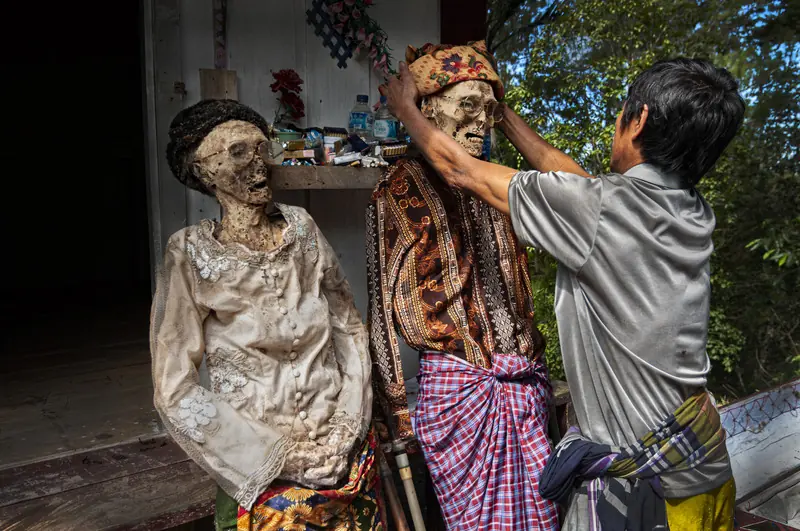Land of Mystery, Culture, and Spectacular Scenery
The highlands of Sulawesi hold Tana Toraja, a land of emerald rice terraces, dramatic hills, and sky-stretching blue horizons. It’s a place where culture is alive and visible in every facet of the region. The Toraja people are warm and welcoming. The spiritual heartbeat of the region is Aluk To Dolo, or the “Way of the Ancestors". This fascinating belief system blends ancient animist traditions with subtle influences of Protestant Christianity, introduced to Sulawesi by the Dutch in the 1920s, creating a distinctive cultural collage that guides daily life, rituals, and ceremonies.
Tana Toraja’s culture is a living tapestry of ancient traditions and eclectic rituals, where every ceremony, wedding, and village gathering bursts with colour, music, and meaning. Thus, life and death are celebrated with equal reverence, revealing a community bound by family, faith, and an extraordinary respect for their ancestors. Visiting Tana Toraja feels like stepping back in time, into a world where every village, home, and ceremony tells a story.
Attractions and cultural highlights
Tana Toraja is a feast for the senses. But it’s not just the scenery—visitors are drawn into a world of fascinating rituals, ceremonies, and centuries-old traditions that make every moment feel like stepping into another time.
Death, burial, and rituals are not the end
For the Toraja, death is a spiritual journey or a profound passage rather than an end. Families may keep mummified relatives in their homes for years before a grand funeral, the Rambu Solo, which can last a week or more. Witness the ritual chants, flute music, cockfights, and buffalo sacrifices that blend grief with celebration. Coffins may be placed in caves, carved cliff graves, or even hung from trees—especially for infants. Wealth and status are reflected in the number of water buffalo sacrificed, which are believed to aid the deceased in reaching Puya, the afterlife.
Another remarkable ritual is Ma’nene, a periodic ceremony where centuries-old corpses are cleaned, dressed, and honoured, strengthening family bonds and connecting the living with their ancestors.
Some of the most iconic burial sites include:
- Lemo, where families carve tombs into steep cliffs, often lining the rock face with wooden effigies called Tau Tau, which are life-sized representations of the deceased gazing over the valley below.
- Kambira, a notable site for its hanging graves—coffins suspended from cliffs or trees, usually for infants and young children, symbolising a return to nature and a connection to the afterlife.
- Londa, a large cave complex where mummified bodies are stored in rock tombs, often accompanied by Tau Tau figures. Visitors can see generations of families kept together, reflecting the Toraja belief that death is a journey to the afterlife.
Have a taste of Torajan tradition
Tana Toraja is a food lover’s paradise, where every meal translates to a taste of local tradition. Savour hearty dishes like Papang, succulent grilled pork infused with aromatic spices; Kasbi, a comforting traditional porridge; and an array of fresh jungle vegetables harvested from the surrounding highlands. These foods aren’t just for everyday meals—they play a central role in ceremonies and festivals, where each dish carries symbolic meaning and celebrates the rich heritage of the Toraja people.
Coffee cultivation also forms the backbone of local life. Toraja coffee is world-renowned for its exceptional quality, prized by connoisseurs everywhere. Its unique herbal aroma, deep brown beans, irregular shapes, and smooth, mild taste also encapsulate how dining here is more than just eating; it’s a way to experience the culture, community, and delicate flavours of this extraordinary region.
Natural landscapes are worth the hike
Tana Toraja’s scenery is mesmerising. The abundant green rice terraces contrast with darker hills, dotted with traditional Tongkonans and small circular fish ponds that double as rice field aquaculture. Batutumonga, in the highlands, offers particularly stunning vistas, perfect for relaxed walks through villages and coffee plantations. Hike to Mount Sesean (2,100m) for a beginner-friendly sunrise or a morning trek with panoramic vistas. Cycle as a means of exploring villages, rice fields, and coffee plantations while stopping at local cafes. A support vehicle often follows to carry luggage and ensure safety.
Shop the Toraja way
Bolu Market comes alive once every six days just outside Rantepao. Here, you can revel in a thrilling glimpse into Toraja tradition. The star attractions are the magnificent buffaloes, from sturdy locals to the rare, dazzling albino buffaloes, each worth tens to hundreds of millions of Rupiah and meticulously groomed to perfection. But the market isn’t just about livestock—bursting stalls of colourful vegetables, tropical fruits, and intricate handwoven textiles make every visit a feast for the eyes and senses, capturing the heart of Toraja culture in one lively scene.
Tongkonan houses and rice barns
The iconic Tongkonan houses, with their massive boat-shaped roofs, are the heart of Toraja life. Built on piles and topped with layered bamboo, these traditional houses embody family ties and ancestral reverence. Meanwhile, the rice barns, or Lumbung Padi, mirror the Tongkonan’s design, reflecting the community’s deep respect for rice as a symbol of wealth and sustenance. Ownership of a Tongkonan marks social status, sometimes requiring years of saving or work abroad to afford one.
Weaving is a tale
Sa’dan and To’Barana villages produce exquisite woven cloths, especially the intricate Paruki motif. The region produces high-quality woven cloth which are sought by people from all over Indonesia and abroad. Visitors can watch and even try traditional weaving. To buy a woven cloth, an interested buyer must place an order and wait for around two weeks, with prices varying depending on the motif.
Getting There
Reaching Tana Toraja is not overly difficult, but it requires some planning since it’s tucked in the highlands of South Sulawesi.
Option 1: Fly into Sultan Hasanuddin International Airport, Makassar, the provincial capital, and then take a six-to eight-hour scenic drive through winding mountain roads to Rantepao, the main gateway to Toraja. Roads are generally in good condition, but travel times can be longer during the rainy season.
Motorboat from Manado Port:
Option 2: Limited flights sometimes connect via local airstrips to Tana Toraja.
Option 3: Mini-buses or private car hires. Have the flexibility and chance to stop at villages, coffee plantations, and viewpoints along the way.
Best Time to Visit Tana Toraja
Dry Season: May to September — ideal for travel and cultural festivals, i.e. highest number of funerals (also the busiest tourist season).
Rainy Season: October to April — travel can be more challenging due to the weather.
Accommodations
Luxury resorts: Toraja Heritage Hotel, Toraja Misiliana Hotel
Mid-range hotels: Santai Toraja
Budget-friendly options: Guesthouses and homestays
Tana Toraja travel essentials
1. Plan around festivals and funerals. Toraja’s unique rituals, like the Rambu Solo funerals, are highlights of the culture. Check local calendars to catch these events, but remember they can also mean larger crowds and higher prices.
2. Dress respectfully, as many ceremonies are deeply spiritual. Modest clothing covering shoulders and knees is recommended, especially when visiting villages or attending rituals.
3. Stay comfortable for hiking and exploring Toraja’s landscapes. Indeed, you'll be captivated by the beauty, but be aware that the landscapes are rugged. Good walking shoes, sun protection, and light layers are essential for trekking hills, rice terraces, and villages.
4. Cash is king. ATMs are limited outside Rantepao, so carry enough cash, especially for small purchases or market visits.
5. Respect local customs by always asking permission before photographing people or sacred sites, especially burial grounds.
6. Be prepared for limited connectivity since both Wi-Fi and cell signal can be spotty in remote villages.
7. Bring basic first aid, insect repellent, and ensure routine vaccinations are up to date for your health and safety.
8. Hire local guides whenever you opt to go trekking, village tours, or cultural experiences. Local guides provide insight that transforms a trip into an unforgettable adventure.
9. Tana Toraja's traditions are deeply sacred. Avoid disruptive behaviour during rituals and support eco-friendly tourism and local artisans.
10. Rent a motorbike if hiring a car and driver isn't your preference.
Tana Toraja is a must-visit destination for those interested in anthropology, history, or simply seeking an extraordinary travel experience. Are you classified as one? Read our related article below for more details.
Discovering the Best of South Sulawesi: Exploring Toraja and Makassar





 Apr 22, 2025
Apr 22, 2025